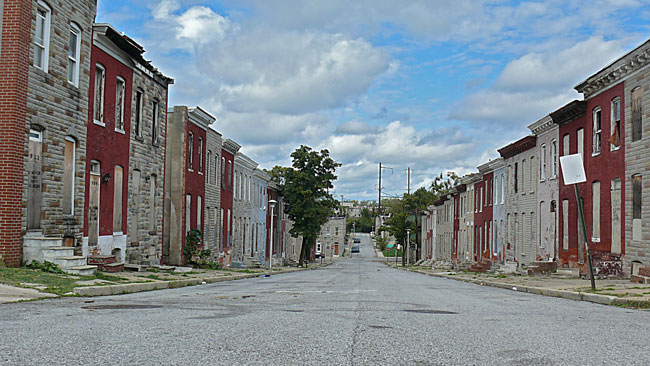
From the Examiner, "How blockbusting (and bigotry) aided the downfall of Baltimore City," by Sean O'Donnell, on 30 March 2010 -- For any Marylander wondering why west Baltimore City and County are black, why Pikesville is Jewish, and why Baltimore County north of the city is white; Antero Pietila’s book Not in My Neighborhood will be provide thought-provoking answers to such earnest questions.
From its beginning, Baltimore’s demographic history is full of quarrelsome tales involving the area’s many groups – whites, blacks, Jews, Catholics, Protestants, and others. According to Pietila, Baltimore’s racial problems were intensified when in 1910 a black lawyer bought a property on McCulloh Street from a white woman.
Later, Baltimore became the first American city to segregate each residential block according to race and afterward, blockbusting had a part in destroying Baltimore. Using a real estate practice aimed at scoring quick profits while destroying neighborhoods along racial lines, realtors (both black and white) used blockbusting during a time when people’s modern attitudes about race and assimilation weren’t prevalent. Instead of allowing natural and gradual desegregation to occur in the city, blockbusting began the urban decay that dominates Baltimore today.
(Note: After the 1954 landmark Supreme Court decision in Brown v. Board of Education desegregating public schools, Baltimore became the first major city to quickly desegregate citywide.)
After World War II, blockbusting combined with tax-payer subsidized housing in the suburbs and highway construction forever changed Baltimore from a white city to a black one.

Pietila does a good job in his book of briefly documenting how racism isn’t just a belief of some whites. In the early 20th century, Democrat Isidor Rayner was elected as the first Jew from Maryland to serve in the U.S. Senate after campaigning on a platform of black disfranchisement. Around the same time Jewish attorney general Isaac Lobe Straus drafted a constitutional amendment to deny blacks the right to vote, but voters eventually defeated the measure. During the 1940s, blacks in Baltimore desperate for jobs ran ads specifying that they would not work as butlers or cooks for Jews. Some blacks even sympathized with Adolf Hitler’s Nazi regime saying that its homogeneity “would be a great help to colored Americans.”
It is interesting that in his book Pietila holds back on blaming his former employer, the Baltimore Sun, as being a significant instigator of Baltimore’s race problems. The Sun classified housing advertisements by race, advocated white supremacy, supported residential segregation, scared readers with headlines reading “Negroes Encroaching,” and printed claims that blacks devastated property values.

While there were some Maryland Republicans who supported racial segregation, it was the Democratic Party who advocated segregation much more than the GOP. In fact, Republicans were usually the fiercest opponents of segregation. When Republican Theodore R. McKeldin was elected as Baltimore’s mayor in 1943, he started tearing apart the segregationist policies his Democratic predecessors had set up. As a mayor, McKeldin advocated equal rights, hired black staff members, named the first black school board member, and ordered that race be eliminated from city job applications. McKeldin brought about these changes when, as Pietila writes, “he did not necessarily have to do so.” “McKeldin was an unusual man. He loved all people – black and white, Jews and Gentiles,” remembered one city councilman.
Conversely, late 19th and early 20th century Democrats in Maryland and Baltimore promoted white supremacy, were obsessed with disfranchising blacks, used violence frequently to scare black voters, committed election fraud, blamed blacks for economic woes, and even came up with a slogan for Baltimore – “This is a White Man’s City.”
No wonder Baltimore is nicknamed “Mobtown.”

As Democrats stained Maryland’s history, Republicans became the mavericks of Baltimore’s political history. The first black elected to the City Council was Harry S. Cummings – a Republican and lawyer.
When discussing eugenics, one intriguing omission from Pietila’s book is his failure to document Planned Parenthood’s enduring history in Baltimore. As he writes, “Baltimore eagerly embraced eugenics… So important is the role of eugenics that much of what follows in this book has some obvious or indirect connection to the movement’s legacy.” However, not once does Pietila mention Planned Parenthood or its racist and eugenic origins aimed to control the populations of “undesirables” and ethnic minorities. Sadly, Planned Parenthood still continues to exploit the poor and downtrodden in the city today.
In the end, Pietila should be applauded for his research and scholarship in Not in My Neighborhood. It is truly an important and controversial 130-year study of, as he puts it, “a great American city” and its demographic change. (source: The Examiner)


No comments:
Post a Comment